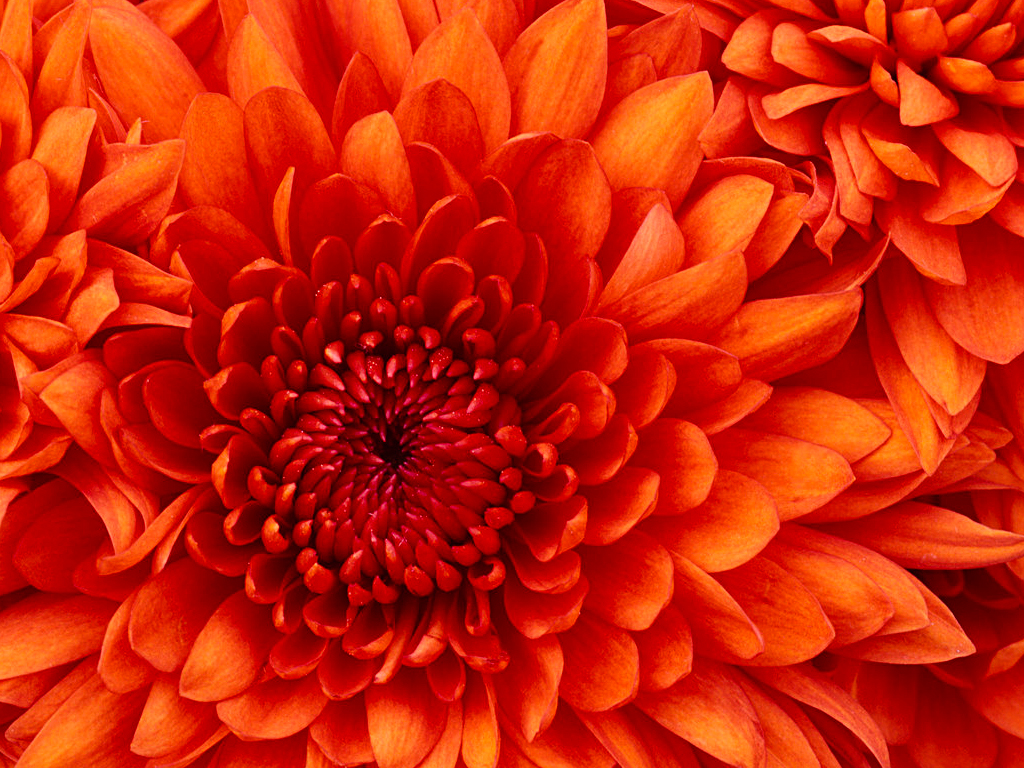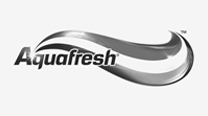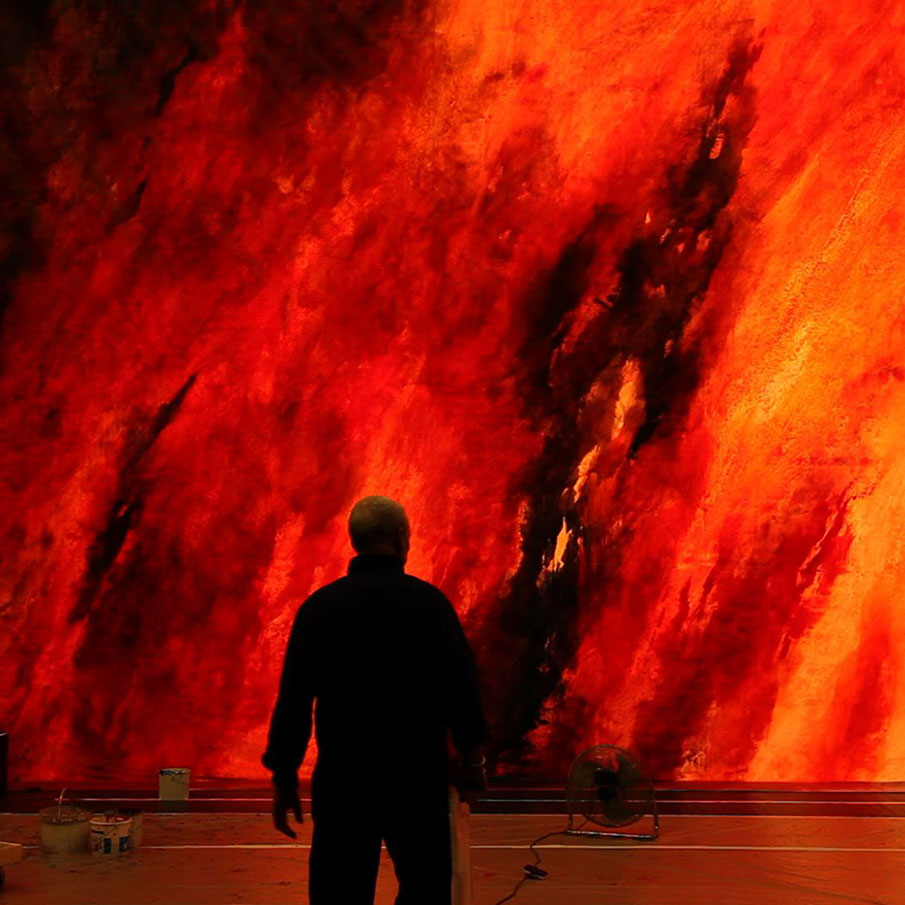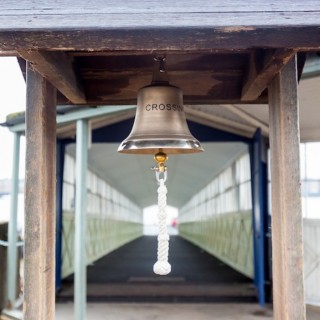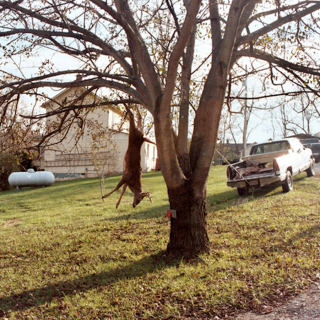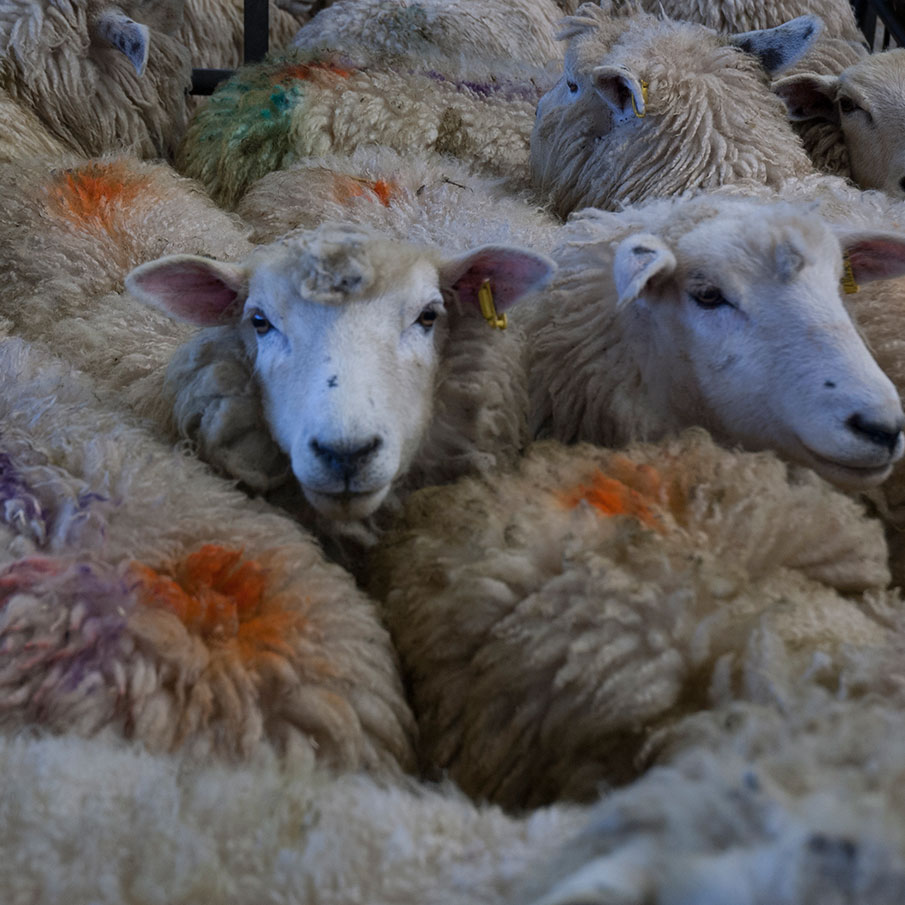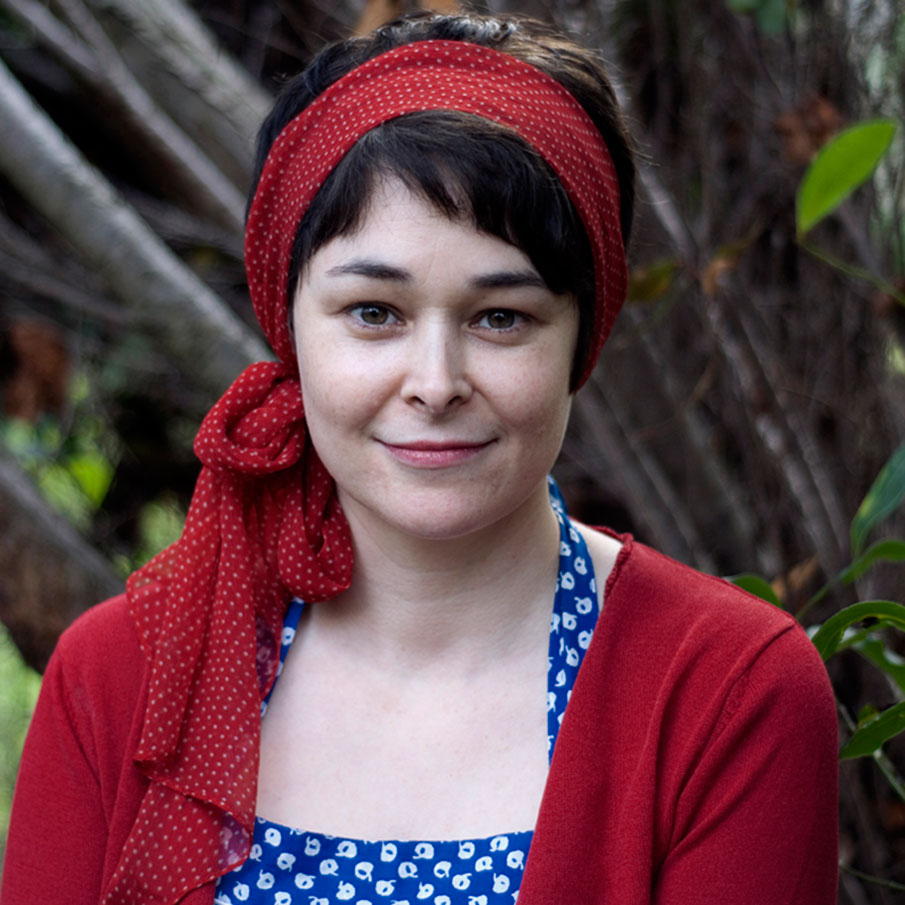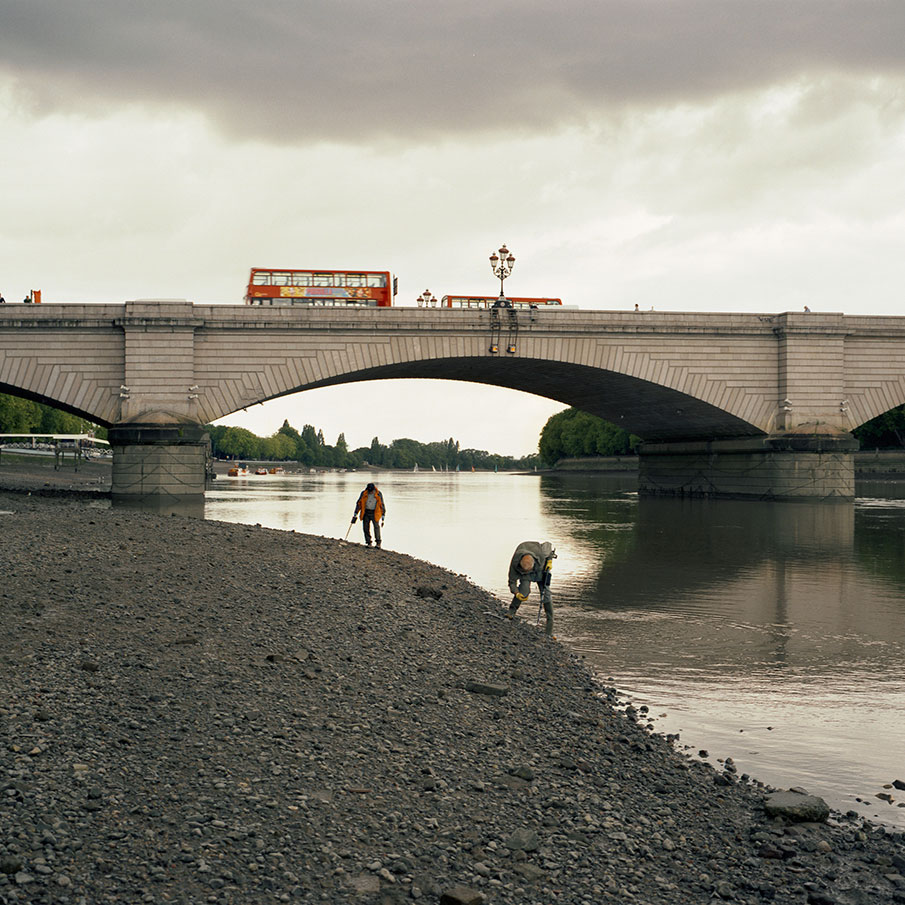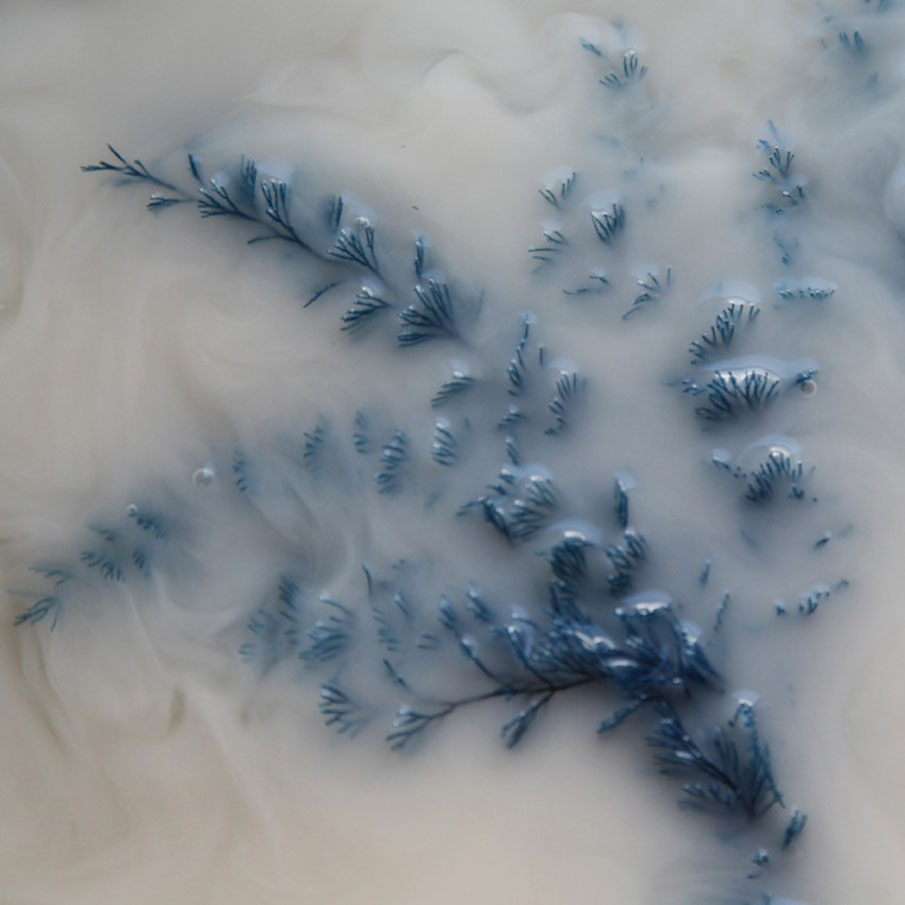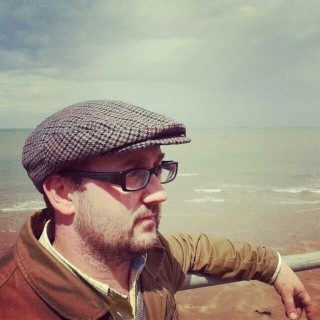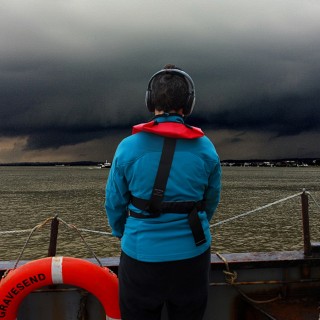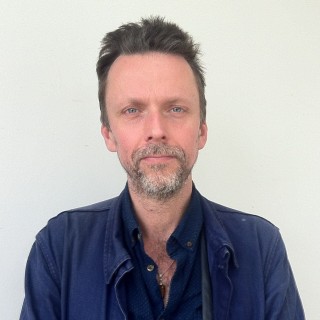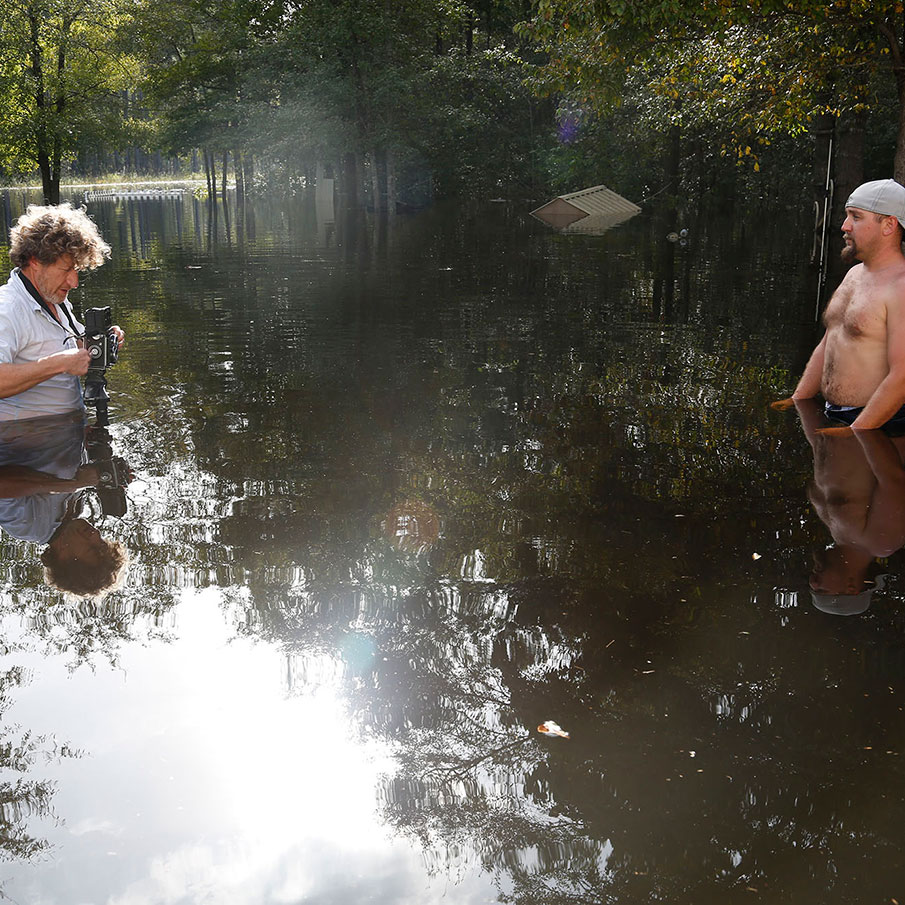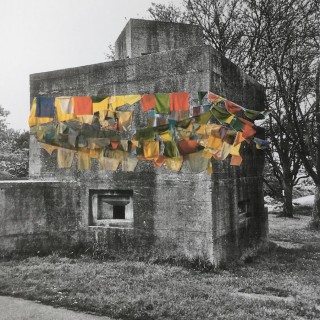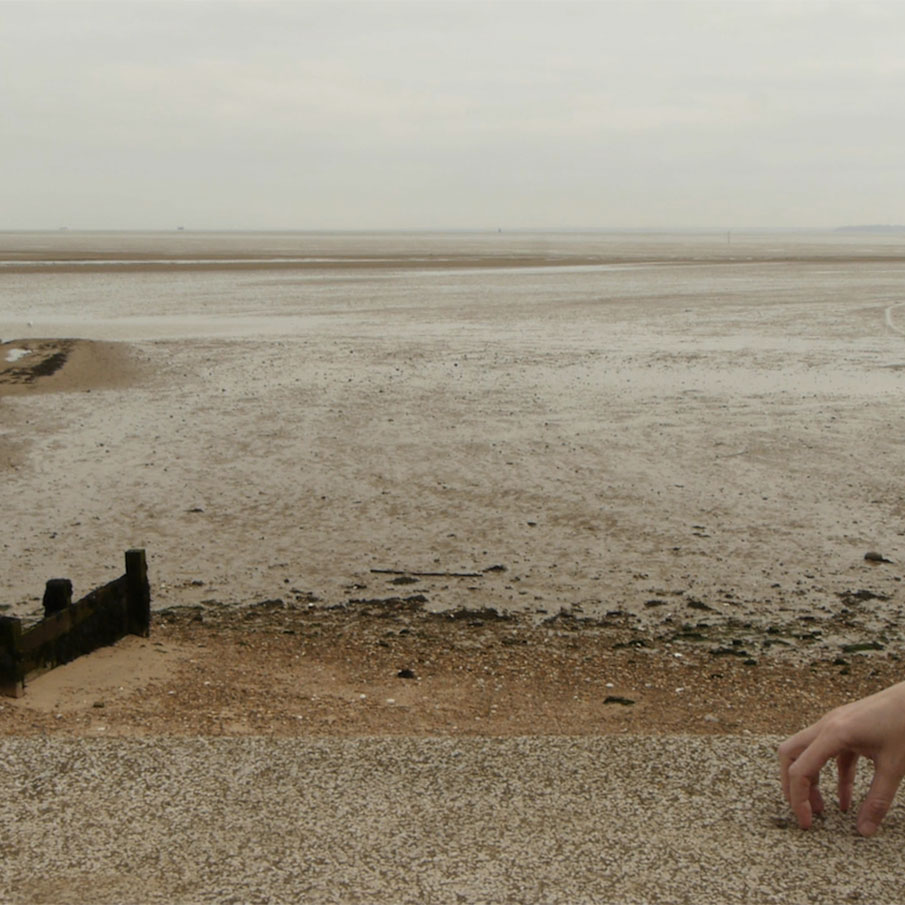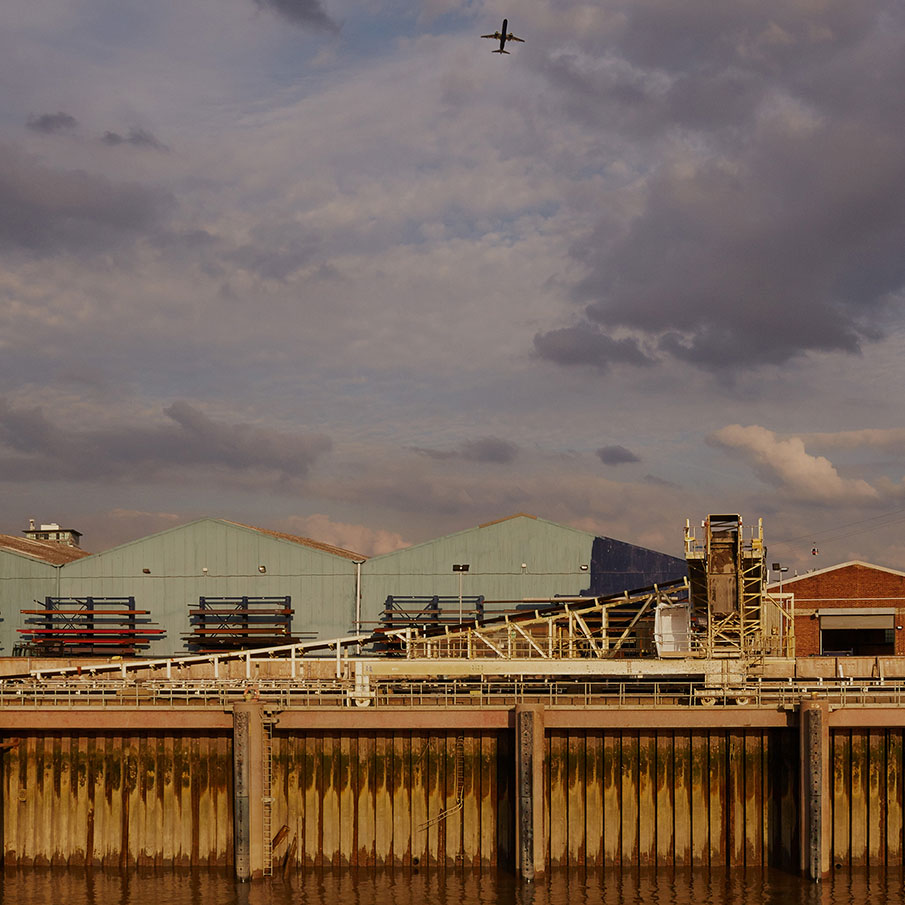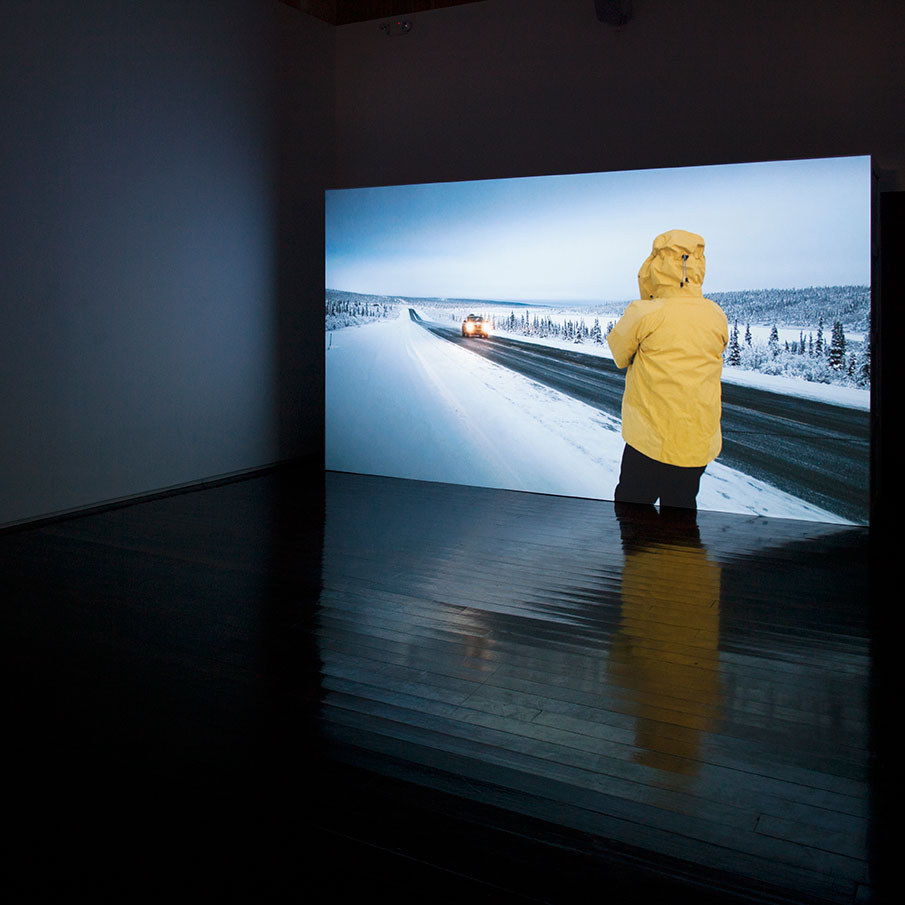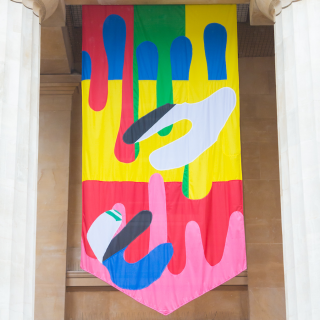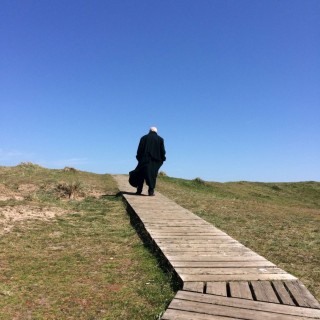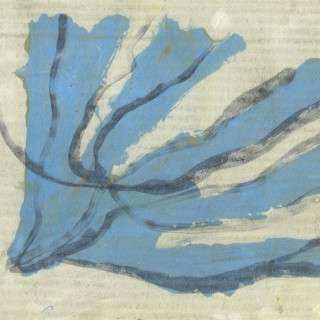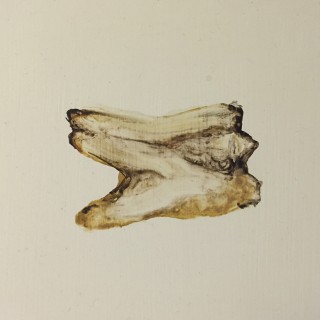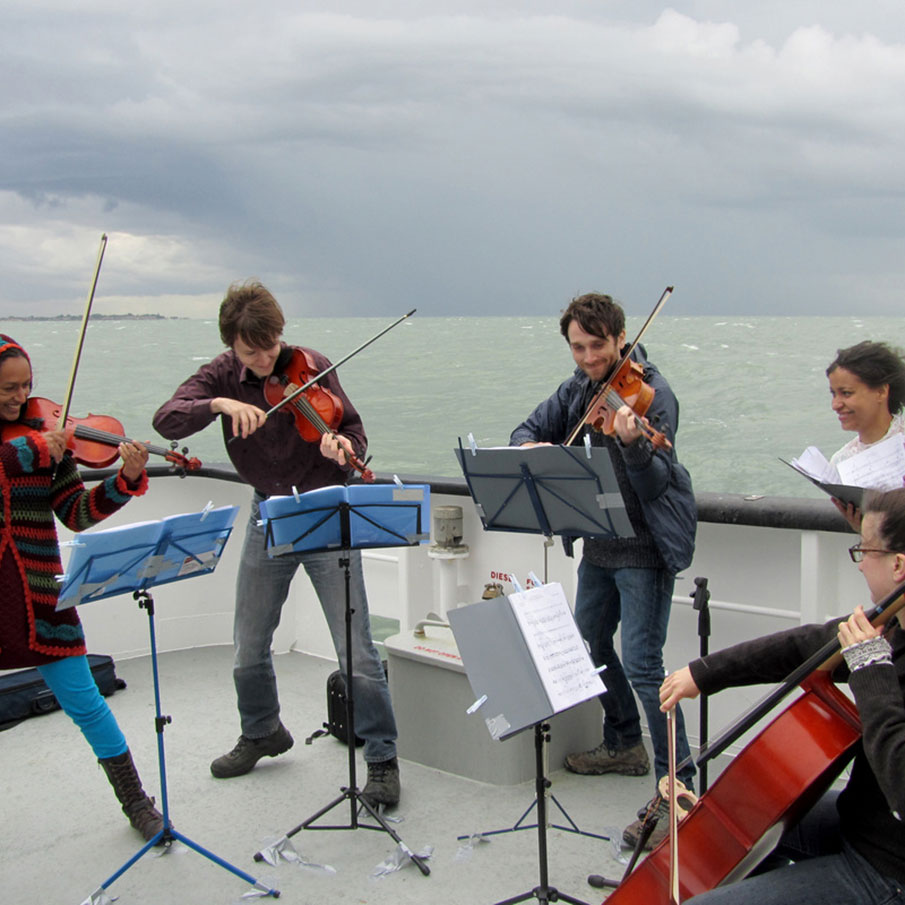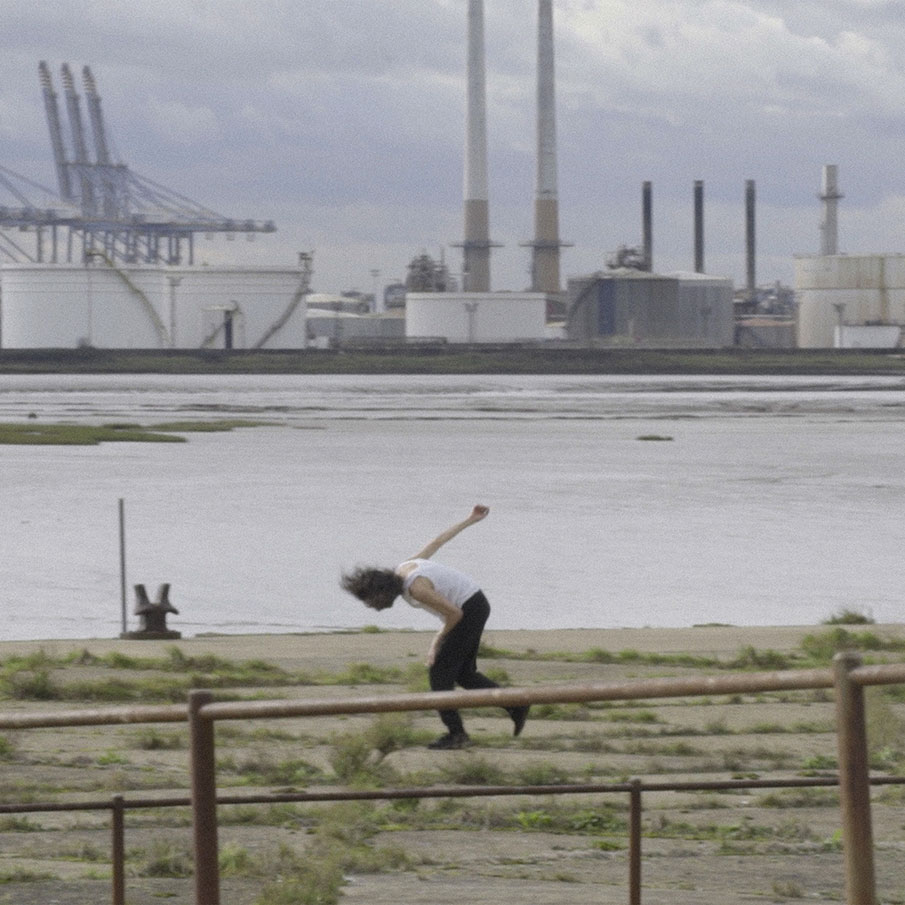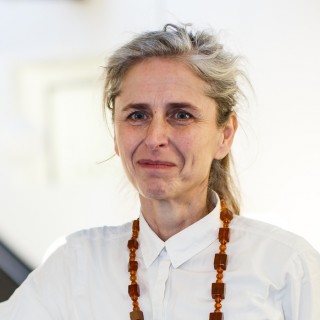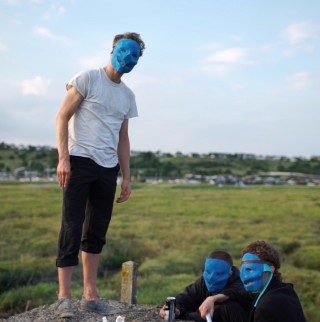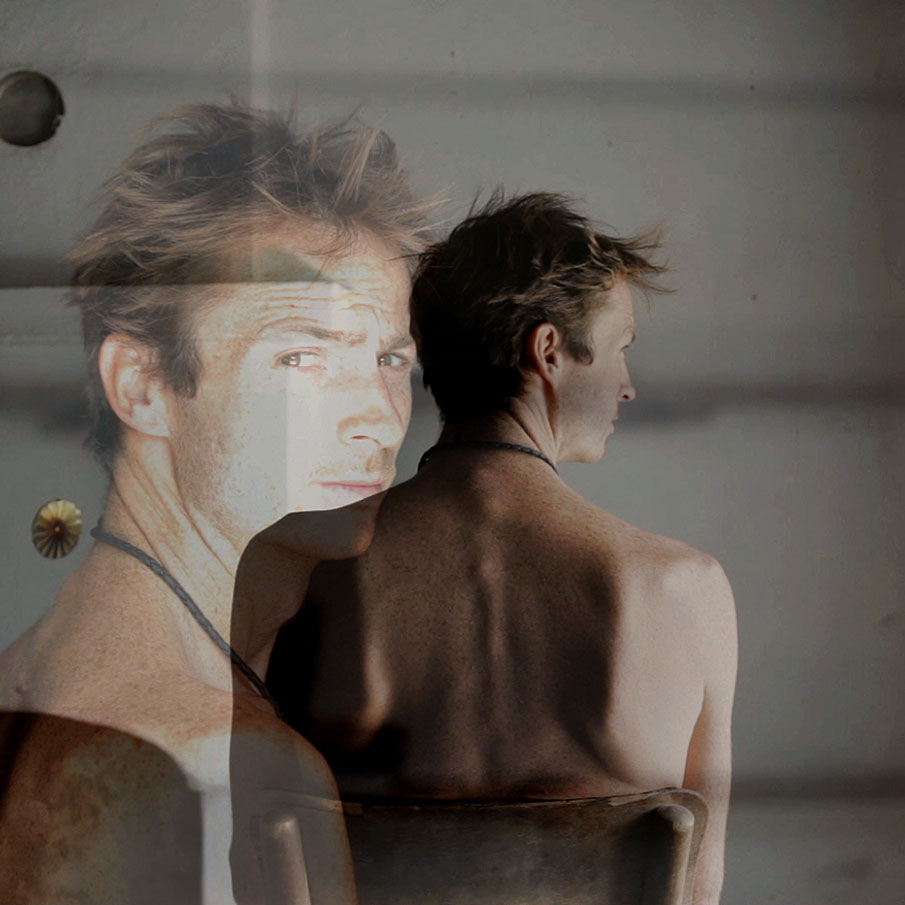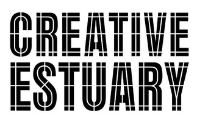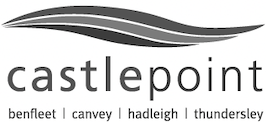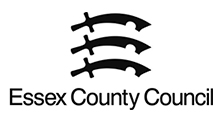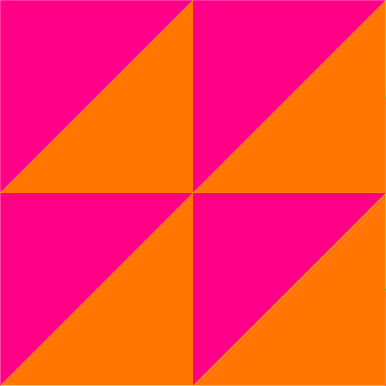Points of Departure
POINTS OF DEPARTURE
Contemporary artists presented new and existing works in the astonishing Grade II* listed Tilbury Cruise Terminal and venues in Gravesend - LV21 ship and Gravesend High Street.
Tilbury Cruise Terminal, Ferry Road, Tilbury RM18 7NG
FULL PROGRAMME HERE
Angus Carlyle, A Crossing Bell (2016)
Installed near the Tilbury ferry within a custom-built wooden shelter that offers views over the wide river, the engraved bell is there to be rung by passengers and festival-goers as they offer their prayers for a crossing (their own or someone else’s, a friend’s or a stranger’s, a crossing here at the Thames or one that lies further afield).
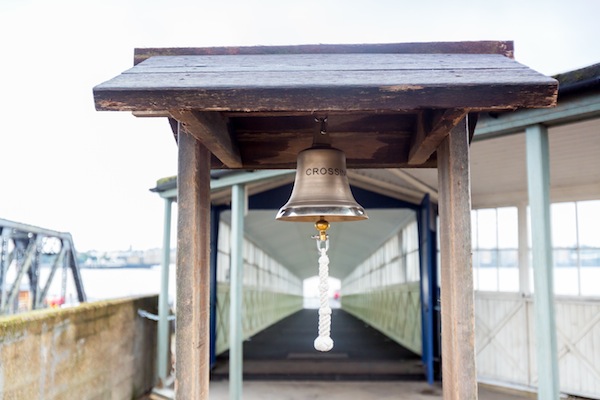
Photo by Benedict Johnson
John Akomfrah, Mnemosyne (2010)
Exhibited for the first time since its premiere at BFI Gallery, Mnemosyne is a powerful film installation that uses a vast array of archival material to hauntingly recast and retell the experiences of postwar immigrants to the UK – resuscitating the now familiar images of our multicultural and diasporic histories. Mnemosyne refers to the mother of the nine Muses, the personification of memory in Greek mythology. Akomfrah’s tone poem is split into verses named after the daughters of Mnemosyne: Tragedy, History, Music, Sacred Song, Astronomy, Comedy, Erotic Love and Dance. The work’s striking sound design was created by Akomfrah’s fellow Black Audio founder, Trevor Mathison.
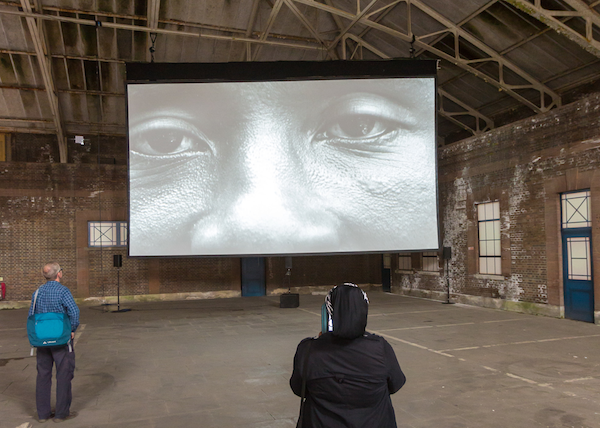 Photo by Benedict Johnson
Photo by Benedict Johnson
Adam Chodzko, Ghost (2010 – 2016)
Ghost is a kayak; a sculpture as vessel, coffin, bed, costume and camera rig. It is designed to ferry people to the ‘island of the dead’, with a rower at the back, and the passenger lying down low and flat in the front, like a body in a coffin with their head slightly raised, travelling along the interface between water and sky. A camera, mounted on Ghost’s deck, records each unique voyage, the passengers’ point of view, from across its bows. The video archives from multiple journeys along four previous Ghost passages (The rivers Swale, Tamar, Tyne and Thames) here joins new video footage made this summer from the Essex Ghost voyages made by a group of estuarine insomniacs, to be shown alongside Ghost itself, held suspended in the Tilbury Cruise Terminal.
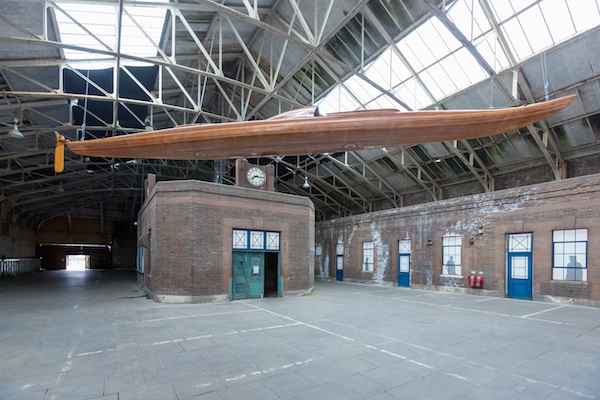
Photo by Benedict Johnson
Taylor Smith, Jelly Belly (2016) Slug and Lettuce (2016) Seasick (2016)
Following a residential Culture LAB at Metal in Southend, Smith shows three new, brief narrative films situated amongst the landscapes and demographics of the Thames Estuary. The first follows an anecdotal recalling of three boys playing out on the mud, set to a disparate exchange of visual narrative threads, flitting from the real to the imagined. The second is less structured and instead follows three adolescents through a maurauding, wandering trip through the Essex marshlands. The third, Seasick details an interview with footballer and Southend United legend Freddy Eastwood that pays homage to the Sky Sports dressing room interview style.
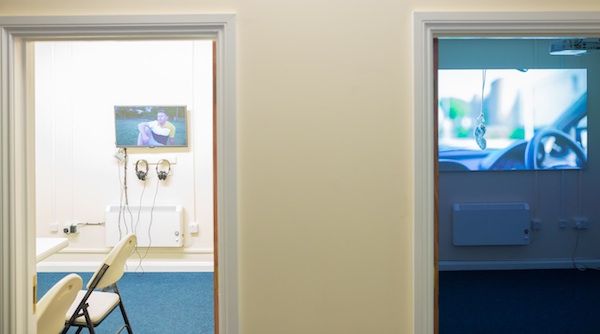 Photo by Benedict Johnson
Photo by Benedict Johnson
Colin Priest, Waiting Rakes (2016)
Often called White Weed, Neptune Plant or even Sea Moss, the harvest of these fragile coral-like plants with rakes, was called white-weeding, and used to be a commonplace seasonal cottage industry across the Thames Estuary. The plants were cleaned, bundled and sold for decorative purposes in the nearby, fabled Moss Shop in Leigh or further afield. Waiting Rakes is a new work by Colin Priest awakening these stories, with a collage of found footage and a collectible daily ‘public notice’ in newspapers the Southend Echo and the Southend Standard during the festival. The installation also includes the film The Dance of the Neptune Plant (Whitstable Biennale 2014).
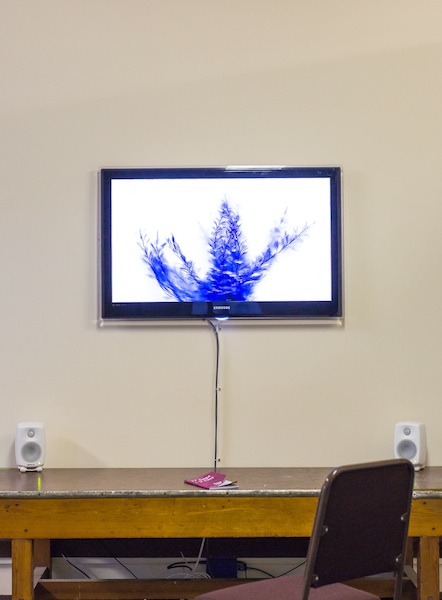 Photo by Benedict Johnson
Photo by Benedict Johnson
Jeremy Deller, Five Memorials (2004)
One of five memorial banners by the Turner Prize winning artist, Five Memorials permanent artwork by Jeremy Deller at Tilbury Cruise Terminal pays tribute to the MV Empire Windrush docking at Tilbury Cruise Terminal in 1948 which marked the start of post-war immigration to the UK.
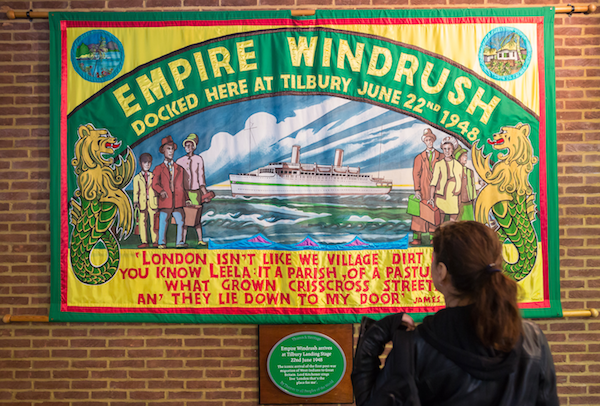 Photo by Benedict Johnson
Photo by Benedict Johnson
Heidi Wigmore, Mind Control Tower (2016)
Following a residential Culture Lab at Metal, contemporary 'prayer flags' recalling the Bata shoe factory's Utopian promise and demand of 'Shoes for All' and the shoes recovered from The London shipwreck. Previewed at Tilbury before being installed at Coalhouse Fort on Sunday 25th September with a live event at 6pm.
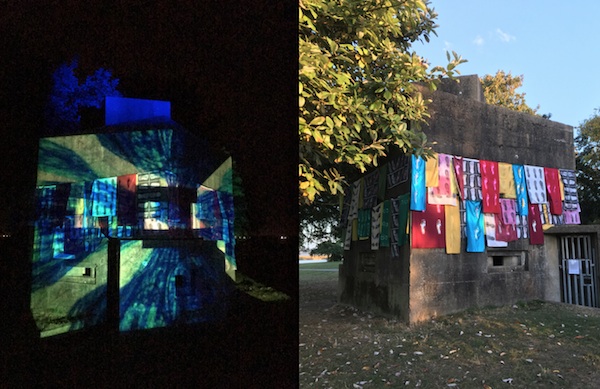 Photo by Michaela Freeman
Photo by Michaela Freeman
Gideon Mendel, Drowning World (2007 – 15)
A series of photographs that explore the personal impact of climate change within a global context, taking us beyond faceless statistics into the individual experiences of victims. Flood survivors are photographed in deep floodwater, within the remains of their homes or in submerged landscapes. The photographs have been taken by Mendel in flood zones around the world, in Haiti, Pakistan, Australia, Thailand, Nigeria, Germany and the Philippines, between 2007 and 2015. Drowning World was shortlisted for the Prix Pictet Prize 2015.
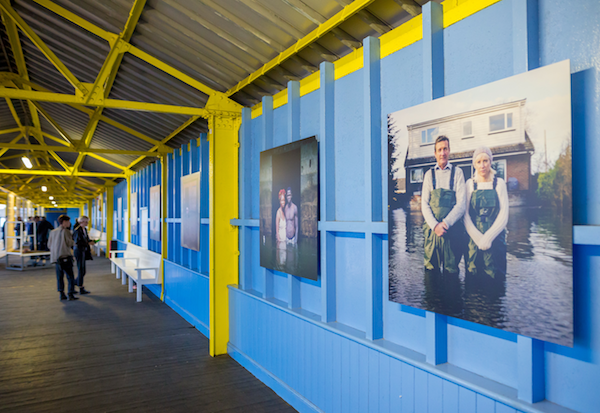 Photo by Benedict Johnson
Photo by Benedict Johnson
Webb-Ellis, MOTHER. I AM GOING (2014)
A three-screen audio-visual installation filmed in an abandoned village in southern Bulgaria, and on the North East coast of England. The work, by British/Canadian filmmakers Webb-Ellis, weaves together documentary, performance and archive footage to explore memory’s relationship with the cinematic image, and the discontinuity of history.
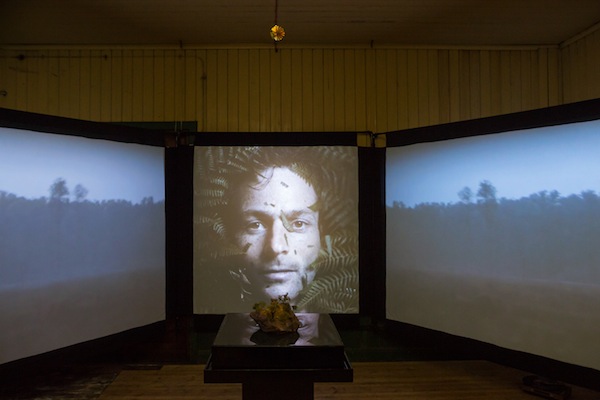 Photo by Benedict Johnson
Photo by Benedict Johnson
French & Mottershead, Waterborne (2016)
An immersive audio work offering listeners an intimate and visceral meditation on their own mortality. Waterborne describes in poetic detail the course of your body’s decay as it traverses time and place, from a canal, via a tidal river, an estuary and out to sea. Word, voice and bodily sensations combine with the ambient sounds of the estuary, working on the imagination to create a self-portrait of your own body as it dissolves and fragments within the different bodies of water. Waterborne is experienced on board a boat or on the waterside, through a spoken narrative, written from forensic case studies of human bodies immersed in and transported by water, combined with site research on the tidal Thames. Trips on the boat took place over the opening weekend (Sat 17 and Sun 18 Sept).
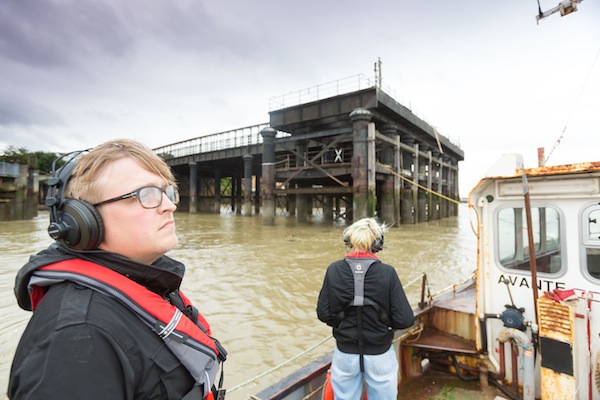 Photo by Benedict Johnson
Photo by Benedict Johnson
Anne Lydiat, I am the ship, the ship is me (2016)
For the past fourteen years Anne Lydiat has been living and working as an artist onboard a vessel moored on the River Thames at Hermitage Moorings, downstream from Tower Bridge. As part of Estuary 2016 Lydiat will sail her barge, MB Rock, down the Thames, mooring on the Lower Landing Stage at Tilbury Cruise Terminal. The vessel will become a camera obscura and will also exhibit video works and drawings made onboard under the title I am the ship, the ship is me, created as part of her recent PhD. Please note: This exhibit is only present during the opening weekend Sat 17 / Sun 18 September.
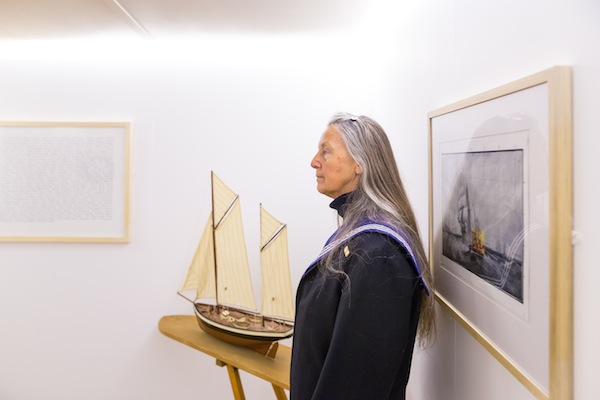 Photo by Benedict Johnson
Photo by Benedict Johnson
Bronwen Buckeridge, Creatures of the Mud (2016)
Sound installation based on a series of visits to sales houses on either side of the estuary that reimagines the auctioning of livestock as a collection of dreams. The penning, bartering and ringside procession of these four-legged animals points to the lost layer of agricultural industry on the river, and draws on the ancient use of the Tilbury ferry as a crossing for sheep, and on its current use for human passengers checking in, queuing and being processed for the departing cruise liners.
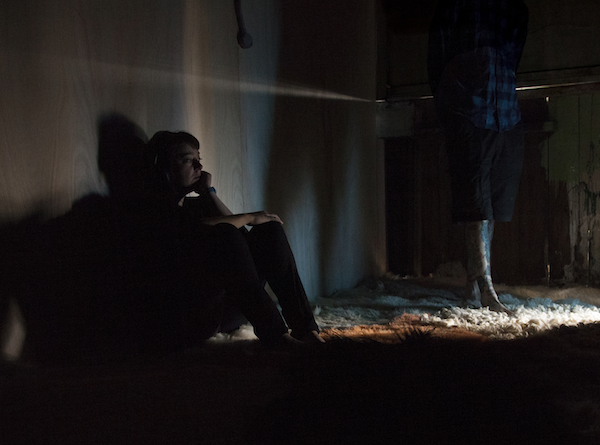 Photo courtesy of the artist
Photo courtesy of the artist
Nastassja Simensky, Colloquy (2014)
Inspired by the wreck of The London, sunk in 1665, and the use of sophisticated sensing technologies to map contested landscapes, Simensky collaborated with composer William Frampton, to create a score for String Quartet and Soprano using the numeric data from hydro-graphic scans of The London and the surrounding sea bed. Colloquy is a film of the original performance that took place aboard a cockle boat in the Thames Estuary performed by the Ligeti String Quartet and Soprano Rachel Duckett in August 2014.
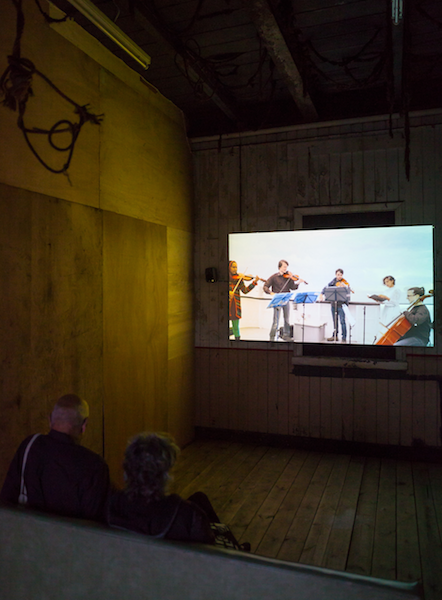 Photo by Benedict Johnson
Photo by Benedict Johnson
Louisa Fairclough, The Incidental Musicality of a Chance Encounter (2016)
A sound installation with accompanying drawings. The drawings are of things found along the Thames that have something of the body: a coughed up pellet, a stone that has the appearance of something chewed, a muddied bovine tooth. Sometimes these are paired to imply the resonance and relationship between things encountered. The field recordings capture the coalescence of events and the incidental musicality of a chance encounter.
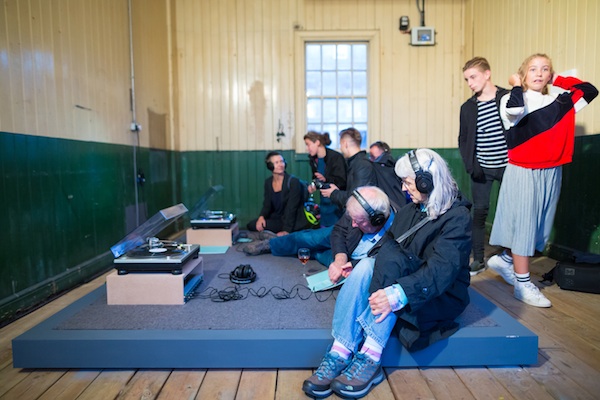 Photo by Benedict Johnson
Photo by Benedict Johnson
Jem Finer, 51o 30’ 44” N, 0o 0’ 38″ E (2015)
An exploration in film and sound of the location of his studio on Trinity Buoy Wharf. Listening and looking eastwards, at the point where the rivers Lea and Thames meet, the work draws on field recordings, musical compositions and films made during all hours of day and night over the course of 12 months. Encompassing the cycles of the seasons and temporal, meteorological and astronomical shifts, the work is presented as a looping film in which the dimension of sound is given priority over the visual. Commissioned by Film and Video Umbrella.
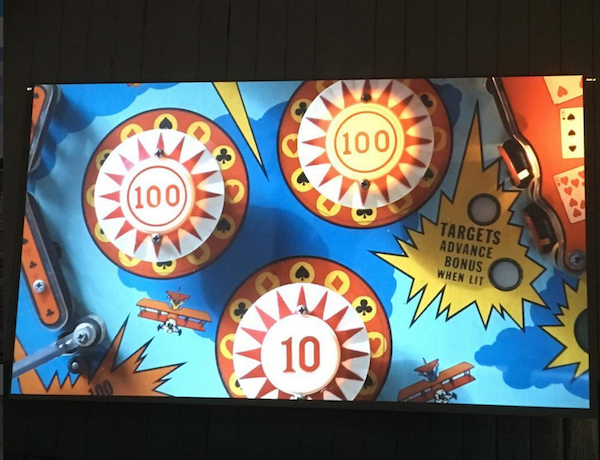 Photo by Michaela Freeman
Photo by Michaela Freeman
Lavinia Greenlaw, The Sea is an Edge and an Ending (2016)
The poet Lavinia Greenlaw’s first film investigates what it means to lose your memory and disappear into the present tense. Its framework is a sequence she wrote about her father’s death from Alzheimer’s. It carries echoes of Shakespeare’s Tempest in its study of a man under a kind of spell, whose child must observe his strange and terrifying liberation. Co-commissioned with Film & Video Umbrella with the support of the Wellcome Trust.
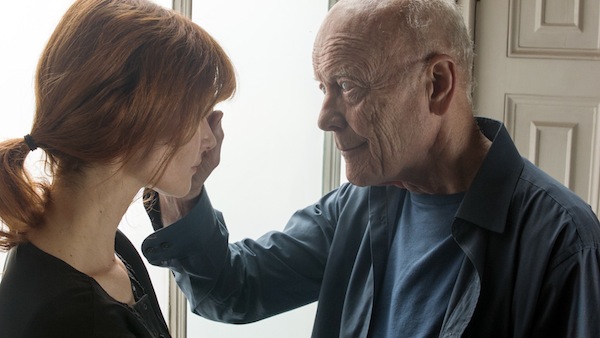
Courtesy: Lavinia Greenlaw
Chloe Dewe Mathews, Offshore Broadcast (2016)
In 1964, a pirate radio station was set up on the Maunsell Sea Forts, a cluster of gun turrets built 7 miles into the mouth of the Thames Estuary to protect London from German invasion during the Second World War. One of the easy listening stations based there, Radio 390, was targeted at housewives, becoming known as Eve: the Women’s Magazine of the Air. In Offshore Broadcast, Chloe Dewe Mathews overlays footage of her own visits to the now derelict sea forts with radio clips of broadcasts made from the platforms in 1965.
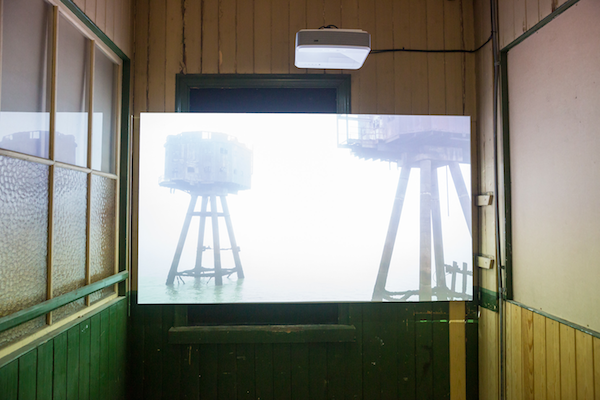 Photo by Benedict Johnson
Photo by Benedict Johnson
Sam Williams, Until they feel – ahead of them – a barrier (2016)
Sam Williams’ film work is a reflection on the human body as a threshold between interior and exterior space. Taking place in the post-industrial estuary landscape, the figures, like the architecture, appear as ghosts caught in cycles of unstable and unproductive gesture. Both they and the landscape appear at a limit, on thresholds of action and inaction, of holding and releasing, falling and walking, expectation and arrival. There is a sense of attempting to see the unseen, the bodies inhabiting conditions of the site and the site exerting pressure upon the bodies.
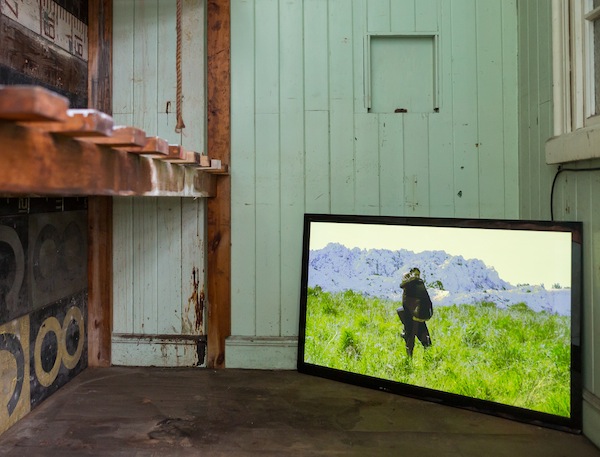 Photo by Benedict Johnson
Photo by Benedict Johnson
Jem Cohen, World Without End (no reported incidents) (2016)
The New York-based filmmaker, photographer, and multimedia artist, well known for his film portraits of urban landscape, spent time in residence with Metal capturing the landscape and people of South East Essex for this new film, premiering at Estuary 2016: ‘I found that the Thames Estuary and its insistent tides brought in not only nature and history, but prize-winning Indian curries, an encyclopaedic universe of hatwear, and a nearly lost world of proto punk music.’
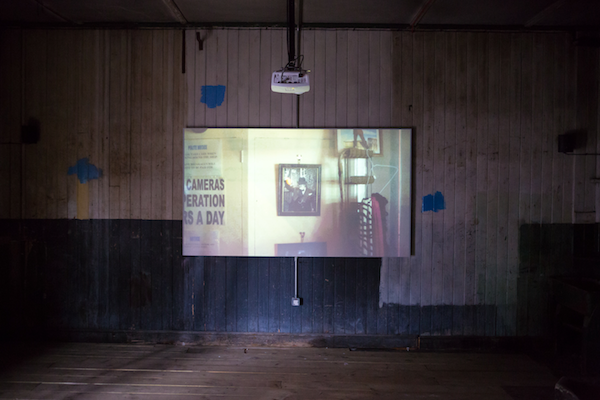 Photo by Benedict Johnson
Photo by Benedict Johnson
Liz Lake, A River Once Ran Through My Veins (2016)
Following a residential Culture LAB at Metal in Southend, this is a new fictional installation for the Tilbury Cruise Terminal. The piece is made from an imagined future where years of silt have long since swallowed the estuary. Icecaps of polystyrene, islands of Buddleia and colonies of crystallised snails now proliferate. Digging down, geological core samples reveal strata of landfill, concrete, aggregate and ash.
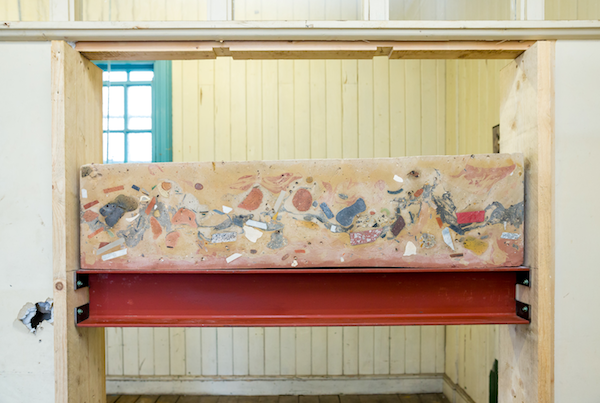 Photo by Benedict Johnson
Photo by Benedict Johnson
Andrew Cross, Waterbased (2016)
Through simple sustained observation, this silent film takes a visual slice through the estuary and its relationship to a wider economic and cultural history. Montaging the activities of the Royal Opera House’s production studios at High House, Purfleet with the workings of the river around the Port of Tilbury, the work reflects on parallels that give underlying character to the area. Within the continuous flow of movement the film highlights moments of precision and craft shared in the traditions of the maritime and the arts. Commissioned by Thurrock Council.
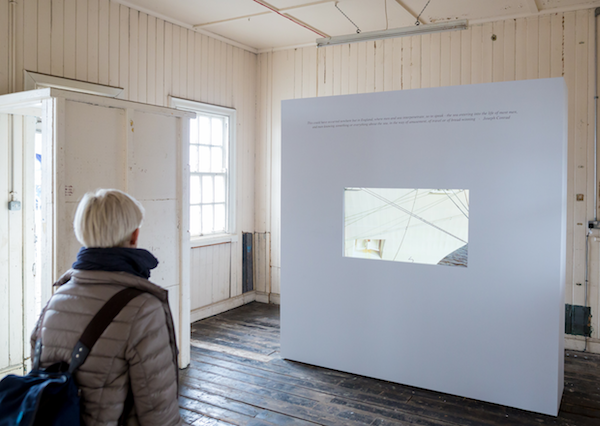 Photo by Benedict Johnson
Photo by Benedict Johnson
Chloe Dewe Mathews, Thames Log (2011 - 2016)
For the last five years, the photographer Chloe Dewe Mathews has been travelling up and down the river Thames, documenting the routines and rituals that take place at the water's edge. Some habitual, some ceremonial, Dewe Mathews has recorded the things she has witnessed during her journey from source to mouth, including ship spotters, mudlarkers, pagans, pentecostal baptisms, coracle adventurers and the scattering of human ashes.
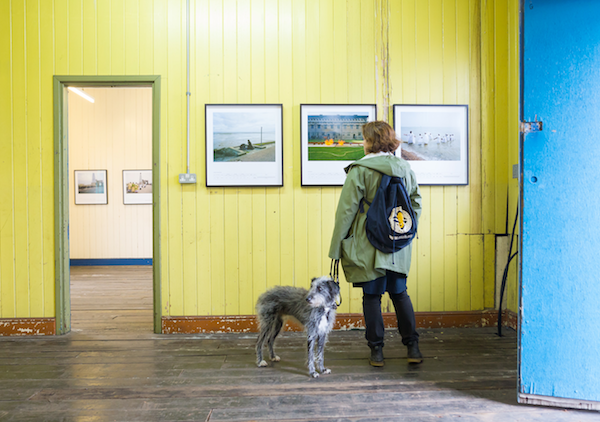 Photo by Benedict Johnson
Photo by Benedict Johnson
Coalhouse Fort:
Mark Donne, Listening with Frontiersman (2016)
Between island and mainland, barbed wire and field, between private and public, sea and land; visited violence and received peace, and ultimately between life and death: Donne’s inter-playing, five screen installation within the Guards Rooms at Coalhouse Fort, examines the silent, implicitly aggressive distinction between one who may “enter” and is permitted “security” and the other … who will not be.
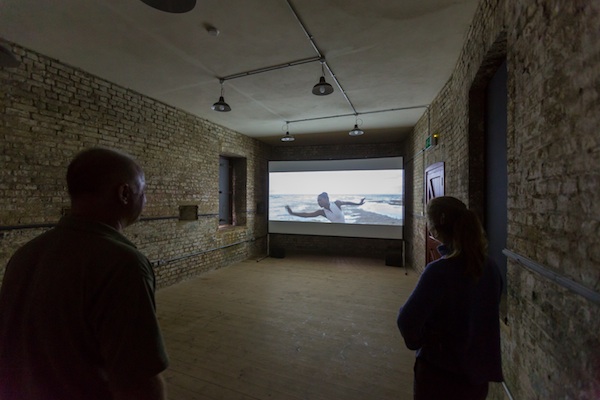 Photo by Benedict Johnson
Photo by Benedict Johnson
Gravesend:
LV21
Built in 1963 Light Vessel 21 is a unique 40 metre steel-hulled lightship, the last of the renowned Philip & Son’s ships to be commissioned by Trinity House. Now a floating arts venue, LV21’s arrival at St. Andrew’s Quay in Gravesend for Estuary 2016 marks the start of an exciting five-month funded research and development activity to explore the rich cultural landscape of Gravesham, connecting with local residents and building new arts and community partnerships across the region.
For Estuary 2016, LV21 will host three artists Cathy Fitzgerald, Anna Lucas and Dan Thompson, exhibiting as part of Points of Departure as well as being a key part of the festival’s education offer for all ages, with workshops, talks and schools tours.
LV21’s move to the Thames has been made possible through the invaluable support of Arts Council England, Gravesham Borough Council and Kent County Council Creative & Cultural Economy Service.
Cathy Fitzgerald, What the River Told Me (2016)
A new oral history radio piece played over a unique radio system that uses the salt water of the estuary itself to transmit sound. The technology used has been developed specifically for Estuary 2016, in collaboration with Tony Churnside and Nick Piggott. What the River Told Me is installed on LV21, at St Andrew’s Quay in Gravesend.
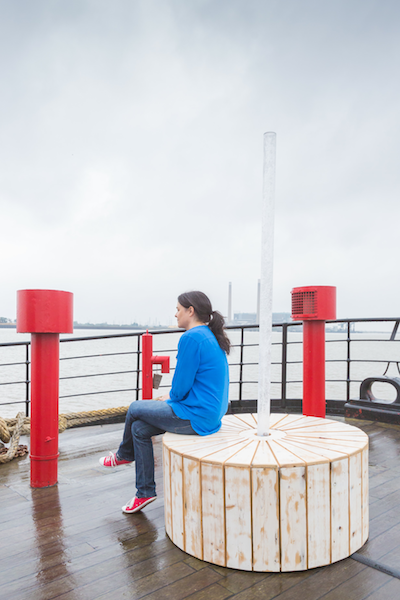 Photo by Benedict Johnson
Photo by Benedict Johnson
Dan Thompson, Empire and Arcardia (2016)
Following a residential Culture LAB at Metal in Southend, three new works exploring themes of empire and arcadia, immigration and emigration. The MV Empire Windrush and the SS Arcadia both docked at Tilbury. Signal flags have been installed simultaneously in Margate (on the outer reaches of the south bank of the Estuary in Kent), and in Tilbury (on the north bank in Essex). The flags are accompanied by a reading room, with a wide range of collected and donated books on the same themes, onboard LV21, at St Andrew’s Quay in Gravesend.
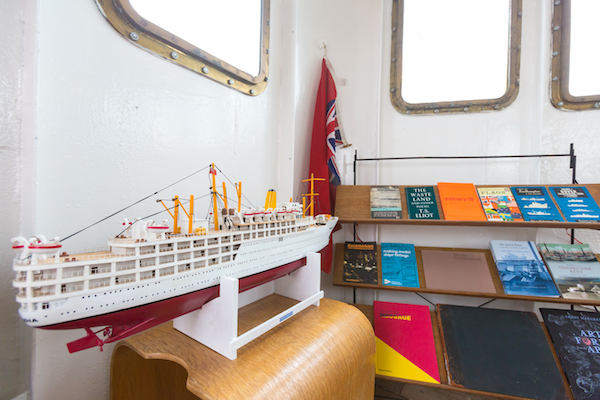 Photo by Benedict Johnson
Photo by Benedict Johnson
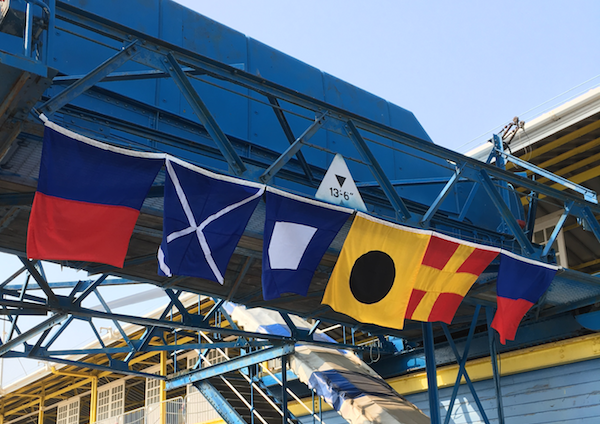 Photo by Michaela Freeman
Photo by Michaela Freeman
Anna Lucas, Little White Feather and the Hunter (2008)
Following an encounter with a lute playing Pocahontas enthusiast in Essex, Lucas travelled around Virginia in the US using the local legend of Pocahontas (who died in Gravesend in 1617) as a virtual guide. This film presents academic and personal accounts of episodes in the life of Pocahontas including interviews with a Chelmsford anthropologist and ancestors of the Powhatan tribe. The work navigates the delicate and passionate opinions of the diverse storytellers, without attempting to uphold factual accuracy, but instead revealing different forms of truth and knowledge. The voices are accompanied by images of hunting and fishing in the estuary landscapes of Essex and Chesapeake Bay, and features shanties and specially written folksongs sung on location in Harwich.
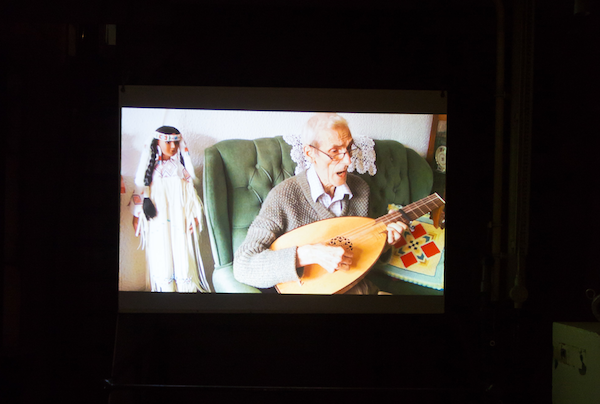 Photo by Benedict Johnson
Photo by Benedict Johnson
Katrin Albrecht, Cut From The Same Cloth (2016)
Deconstructed and abstract flags of western nations cut together with those of Syria, Afghanistan and Iraq only hint at their former representational function, with new, serendipitous, patterns signifying the commonalities between nations and human beings. Exhibited for the duration of Estuary 2016 in Gravesend High Street.
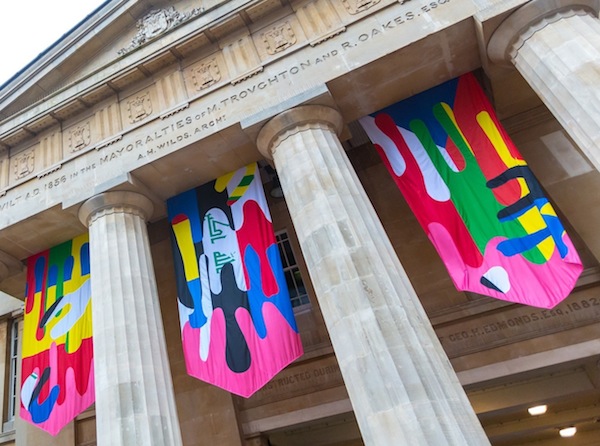 Photo by Benedict Johnson
Photo by Benedict Johnson

 maybe later
maybe later
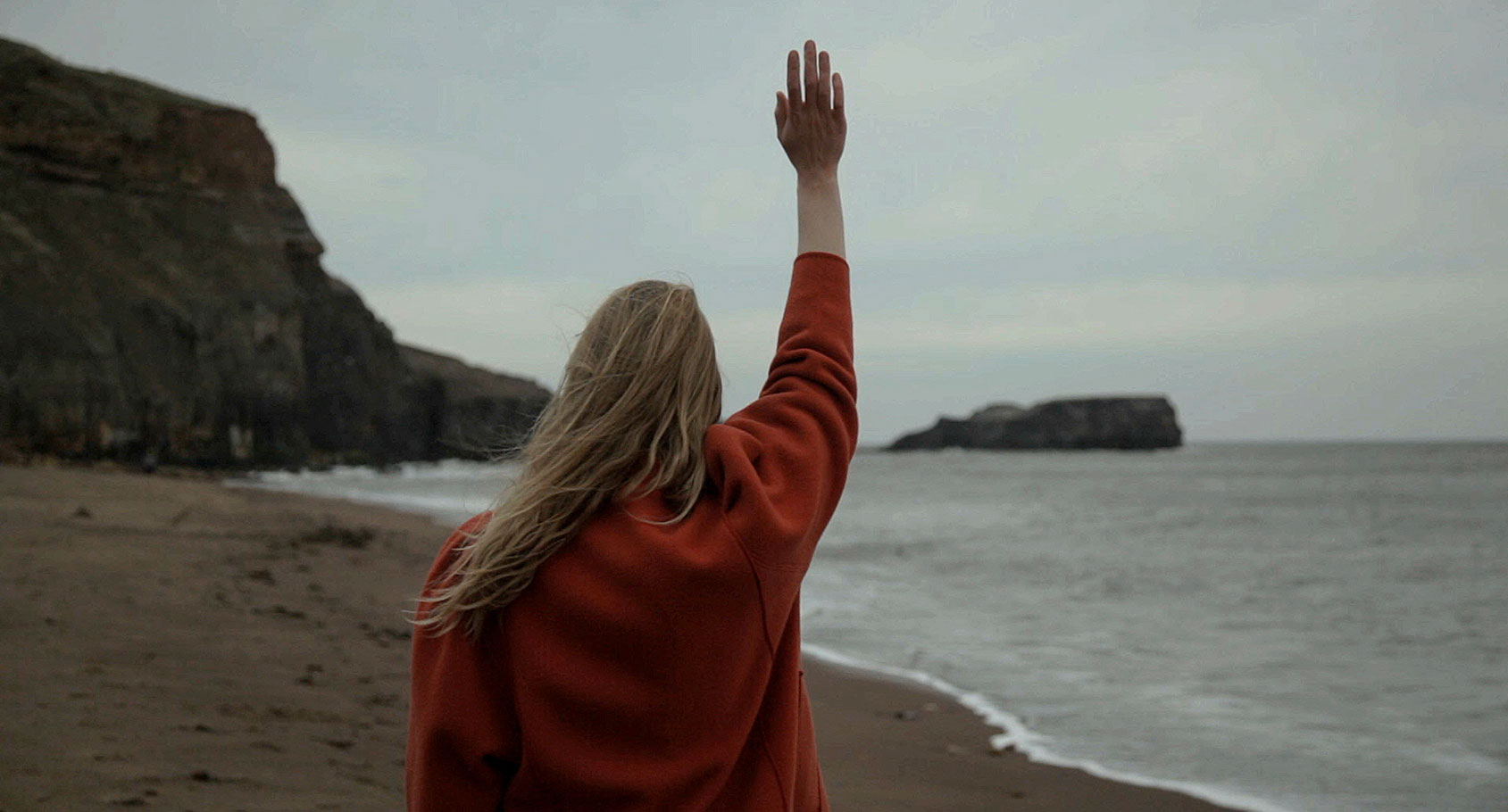
 Photo by Benedict Johnson
Photo by Benedict Johnson Photo by Benedict Johnson
Photo by Benedict Johnson Photo by Benedict Johnson
Photo by Benedict Johnson Photo by Benedict Johnson
Photo by Benedict Johnson Photo by Benedict Johnson
Photo by Benedict Johnson Photo by Benedict Johnson
Photo by Benedict Johnson Photo by Michaela Freeman
Photo by Michaela Freeman Photo by Benedict Johnson
Photo by Benedict Johnson Photo by Benedict Johnson
Photo by Benedict Johnson Photo by Benedict Johnson
Photo by Benedict Johnson Photo by Benedict Johnson
Photo by Benedict Johnson Photo courtesy of the artist
Photo courtesy of the artist Photo by Benedict Johnson
Photo by Benedict Johnson Photo by Benedict Johnson
Photo by Benedict Johnson Photo by Michaela Freeman
Photo by Michaela Freeman Courtesy: Lavinia Greenlaw
Courtesy: Lavinia Greenlaw Photo by Benedict Johnson
Photo by Benedict Johnson  Photo by Benedict Johnson
Photo by Benedict Johnson  Photo by Benedict Johnson
Photo by Benedict Johnson Photo by Benedict Johnson
Photo by Benedict Johnson  Photo by Benedict Johnson
Photo by Benedict Johnson Photo by Benedict Johnson
Photo by Benedict Johnson  Photo by Benedict Johnson
Photo by Benedict Johnson  Photo by Benedict Johnson
Photo by Benedict Johnson  Photo by Benedict Johnson
Photo by Benedict Johnson  Photo by Michaela Freeman
Photo by Michaela Freeman Photo by Benedict Johnson
Photo by Benedict Johnson  Photo by Benedict Johnson
Photo by Benedict Johnson